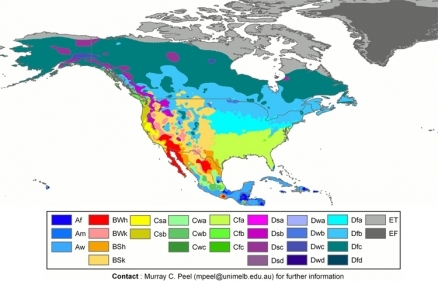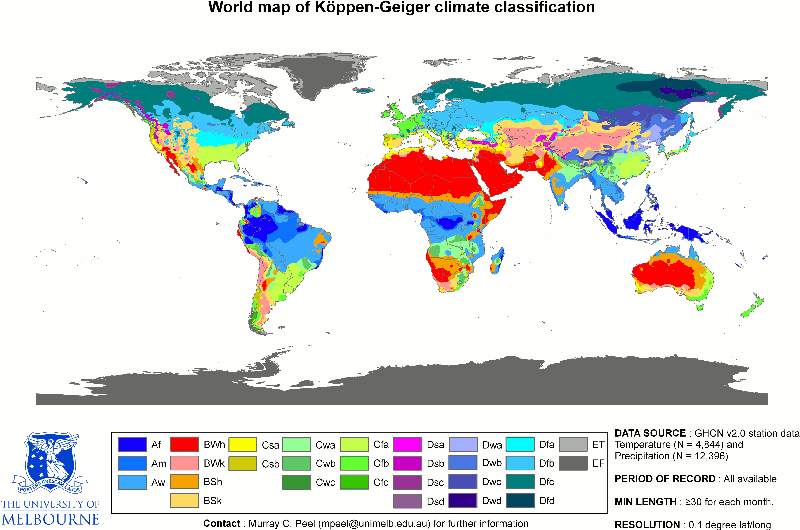Köppen Climate Classification System
The Köppen Climate Classification System is the most widespread system used to classify the climates of places on our planet. The system was developed German climatologist and amateur botanist Wladimir Köppen (1846-1940) who divided the world's climates into several major categories based upon general temperature profile related to latitude.
The Köppen Climate Classification System is a empirical system based on observable features. Other systems are either "genetic" classification systems (based on the causes of the climate like solar radiation, air masses, pressure systems, etc. ) or "applied" classification systems created for, or as an outgrowth of, a particular climate-associated problem. (e.g., Thornthwaite classification system based on potential evapotranspiration.)
The classical length of record to determine the climate for any particular place is 30 years, as defined by the World Meteorological Organization (WMO). The quantities most often observed are temperature, precipitation, and wind. The "normals" are computed once every 10 years which helps to smooth out year-to-year variations. For example, the current 30-year normals were calculated from the actual weather data that occurred during the 30 years of 1971-2000. In 2011, a new set of 30-year normals will be calculated using the data from the period of 1981-2010. So, when you hear what the normal high and low temperature for your location, for example, they come from these 30-year averages.
The Köppen system classifies a location’s climate mainly using annual and monthly averages of temperature and precipitation. A version of the Köppen system is plotted on a map in Figure 1 (see link for high resolution version).
This version of the Köppen system contains up to three levels of sorting based primarily on temperature and precipitation information.
Contents
Major Köppen Climate Categories
The first level recognizes six major climatic types with each group being designated by a capital letter. These major climate categories have the following broad characteristics:
|
A - Tropical Moist Climates: These are very warm climates found in the tropics that experience high quantities of precipitation. The primary distinguishing characteristic of these climates is all months have average temperatures above 18°C (64°F). | |
|
B - Dry Climates: These are climates that experience little precipitation during most of the year. Further, potential losses of water from evaporation and transpiration greatly exceed atmospheric input. | |
|
C - Moist Mid-latitude Climates with Mild Winters: In these climates, summer temperatures are warm to hot and winters are mild. The primary distinguishing characteristic of these climates is the coldest month has an average temperature between 18°C (64°F) and -3°C (27°F). | |
|
D - Moist Mid-Latitude Climates with Cold Winters: In these climates, summer temperatures are warm and winters are cold. The primary distinguishing characteristic of these climates is the average temperature of warmest month exceeds 10°C (50°F), and average temperature of coldest is below -3°C (27°F). | |
|
E - Polar Climates: These climates have very cold winters and summers, with no real summer season. The primary distinguishing characteristic of these climates is the warmest month has an average temperature below 10°C (50°F). | |
|
H - Highland Climates: These are climates that are strongly influenced by the effects of altitude. As a result, the climate of such locations is rather different from places with low elevations at similar latitudes. |
Secondary Köppen Climate Categories
At the secondary level, the major climate groups are further subdivided according to the seasonal distribution of precipitation, the degree of aridity, or the presence/absence of permanent ice.
- Lowercase letters f, w, and s are used to distinguish precipitation patterns and are only applicable to A, C, and D climates.Thus, for example, within the major climate category, A - Tropical Moist Climates, are the subcategories:
- Uppercase W and S identify desert (arid) or steppe (semiarid) climate subtypes for the Dry Climates (B) major category. Thus:
- For the Polar Climates (E), the secondary letters F and T distinguish whether the site is covered by permanent ice fields and glaciers or free of snow and ice during the summer season. Thus:
Major climate types B, C, and D can be further sorted according to a third category. This level is used to distinguish particular temperature characteristics found in these climates.
- In B climates, the lowercase letter h identifies a subtropical location where average annual temperature is above 18°C (64°F). Cooler mid-latitude Dry Climates are distinguished with a lowercase k. Thus:
- For C and D climates the tertiary level letters a, b, c, and d are used to distinguish different monthly temperature characteristics. Thus:
The Complete Köppen Climates
| Af | Tropical Wet |
No dry season. The driest month has at least 60 mm (2.4") of rain. Rainfall is generally evenly distributed throughout the year. All average monthly temperatures are greater than 18°C (64°F). |
|---|---|---|
| Am | Tropical Monsoonal | Pronounced wet season. Short dry season. There are one or more months with less than 60 mm (2.4"). All average monthly temperatures are greater than 64°F (18°C). Highest annual temperature occurs just prior to the rainy season. |
| Aw | Tropical Wet & Dry |
Winter dry season. There are more than two months with less than 60 mm (2.4") . All average monthly temperatures are greater than 18°C (64°F). |
| BSh | Subtropical Dry Semiarid (Steppe |
Low-latitude dry. Evaporation exceeds precipitation on average but is less than potential evaporation. Average temperature is more than 18°C (64°F). |
| BSk | Mid-latitude Dry Semiarid (Steppe) |
Mid-latitude dry. Evaporation exceeds precipitation on average but is less than potential evaporation. Average temperature is less than 18°C (64°F). |
| BWh | Subtropical Dry Arid (Desert) |
Low-latitude desert. Evaporation exceeds precipitation on average but is less than half potential evaporation. Average temperature is more than 18°C (64°F). Frost is absent or infrequent. |
| BWk | Mid-latitude Dry Arid (Desert) |
Mid-latitude desert. Evaporation exceeds precipitation on average but is less than half potential evaporation. Average temperature is less than 18°C (64°F). Winter has below freezing temperatures. |
| Cfa | Humid Subtropical |
Mild with no dry season, hot summer. Average temperature of warmest months are over 22°C (72°F). Average temperature of coldest month is under 18°C (64°F). Year around rainfall but highly variable. |
| Cfb | Marine - Mild WInter | Mild with no dry season, warm summer. Average temperature of all months is lower than 22°C (72°F). At least four months with average temperatures over 50°F (10°C). Year around equally spread rainfall. |
| Cfc | Marine - Cool Winter | Mild with no dry season, cool summer. Average temperature of all months is lower than 22°C (72°F). There are one to three months with average temperatures over 50°F (10°C). Year around equally spread rainfall. |
| Csa | Mild with dry, hot summer. Warmest month has average temperature more than 72°F (22°C). At least four months with average temperatures over 50°F (10°C). Frost danger in winter. At least three times as much precipitation during wettest winter months as in the driest summer month. | |
| Csb | Coastal Mediterranean | Mild with cool, dry summer. No month with average temperature of warmest months are over 22°C (72°F). At least four months with average temperatures over 50°F (10°C). Frost danger in winter. At least three times as much precipitation during wettest winter months as in the driest summer month. |
| Cwa | Dry Winter, Wet Summer | Mild with dry winter, hot and wet summer. |
| Dfa | Humid Continental Hot Summer, Wet All Year | Humid with hot summer. |
| Dfb | Humid Continental Mild Summer, Wet All Year | Humid with severe winter, no dry season, warm summer. |
| Dfc | Subarctic With Cool Summer, Wet All Year | Severe winter, no dry season, cool summer. |
| Dfd | Severe, very cold winter, no dry season, cool summer. | |
| Dwa | Humid Continental Hot Summer, Wet All Year | Humid with severe, dry winter, hot summer. |
| Dwb | Humid Continental Mild Summer, Dry Winter | Humid with severe, dry winter, warm summer. |
| Dwc | Subarctic With Cool Summer, Dry Winter | Severe, dry winter, cool summer. |
| Dwd | Severe, very cold and dry winter, cool summer. | |
| ET | Tundra | Polar tundra, no true summer. |
| EF | Ice Cap | Perennial ice. |
| H |
Highland Climate |
Can encompass any of the above classifications due to the mountainous terrain. |
Online Köppen Maps
References
- Aguado, E. and James E. Burt. 2010. Understanding Weather and Climate. Fifth Edition. Prentice Hall, Upper Saddle River, New Jersey.
- Ahrens, C. D. 2006. Meteorology Today. An Introduction to Weather, Climate, and the Environment. Eighth Edition. Thompson, Brooks/Cole. USA.
- Lutgens, F.K. and E.J. Tarbuck. 2004. The Atmosphere: An Introduction to Meteorology. NinthEdition. Prentice Hall, Upper Saddle River, New Jersey.
- Lydolph, P.E. 1985. The Climate of the Earth. Rowman and Allanheld Publishers, Totowa, New Jersey.
- NOAA.Climate, JetStream - Online School for Weather, National Weather Service.
- NOAA.Climate Classification.
- Oliver, J.E. and J.J. Hidore. 2002. Climatology: An Atmospheric Science. Second Edition. Prentice Hall, Upper Saddle River, New Jersey.
- Peel, Murray C. 2011. Updated Köppen-Geiger Climate Map of the World. http://people.eng.unimelb.edu.au/mpeel/koppen.html







